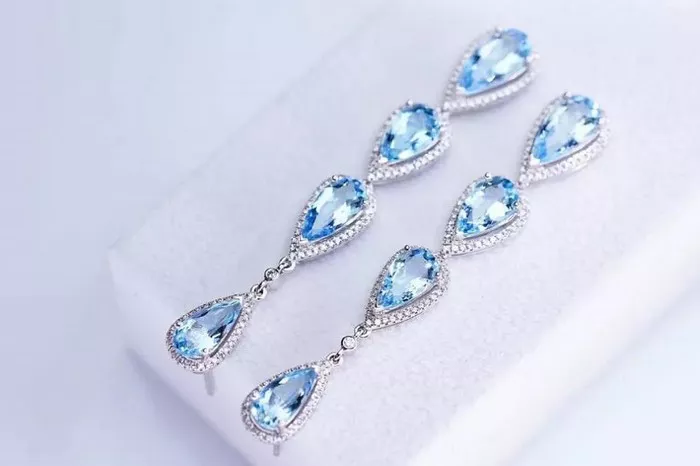Aquamarine and Blue Topaz are two popular gemstones often chosen for their stunning blue hues and affordability compared to other blue gemstones like sapphires. However, they have distinct differences in terms of properties, origins, and uses. This article provides an in-depth comparison to help you make an informed choice when selecting between these two beautiful stones.
Origin and Formation
Aquamarine
Aquamarine, a member of the beryl family, derives its name from the Latin words “aqua” (water) and “marina” (sea). This gemstone forms in granitic pegmatites and is typically found in countries like Brazil, Pakistan, and Madagascar. The color of aquamarine ranges from pale blue to deep blue, often with a hint of green, influenced by the presence of iron.
Blue Topaz
Blue Topaz, on the other hand, is a variety of topaz that gets its blue color from treatments rather than natural formation. Naturally occurring blue topaz is quite rare. Most blue topaz on the market is treated, with colorless or pale topaz being irradiated and heat-treated to achieve a more desirable blue hue. Major sources of topaz include Brazil, Nigeria, and Sri Lanka.
Physical and Chemical Properties
Aquamarine
Chemical Composition: Be₃Al₂Si₆O₁₈
Hardness: 7.5 to 8 on the Mohs scale
Refractive Index: 1.57 to 1.58
Specific Gravity: 2.68 to 2.74
Aquamarine’s durability makes it suitable for various types of jewelry, and its relatively high hardness ensures resistance to scratches.
Blue Topaz
Chemical Composition: Al₂SiO₄(F,OH)₂
Hardness: 8 on the Mohs scale
Refractive Index: 1.61 to 1.62
Specific Gravity: 3.49 to 3.57
Blue Topaz is harder than aquamarine and has a higher specific gravity, making it heavier and more robust.
Color and Clarity
Aquamarine
Aquamarine’s color is usually light to medium blue, with darker stones being more valuable. It often has excellent clarity, with few inclusions visible to the naked eye. The most prized aquamarines exhibit a deep, vivid blue.
Blue Topaz
Blue Topaz comes in various shades, from pale sky blue to deep London blue. It typically has very high clarity, often free from inclusions due to the treatment process it undergoes. The London blue variety is especially popular for its deep, rich color.
Market Value and Affordability
Aquamarine
Aquamarine tends to be more expensive than Blue Topaz due to its natural formation and desirability. Prices can vary significantly based on color intensity, size, and clarity. The deeper and more vivid the blue, the higher the value.
Blue Topaz
Blue Topaz is generally more affordable than aquamarine, primarily because of its abundance and the treatments it undergoes to achieve its color. The price also varies with the shade of blue, with London blue being more expensive than lighter shades like Swiss blue and sky blue.
Uses in Jewelry
Aquamarine
Aquamarine is a versatile gemstone used in a wide range of jewelry, including rings, earrings, necklaces, and bracelets. Its durability makes it an excellent choice for everyday wear. Additionally, its association with the sea makes it a popular choice for nautical-themed jewelry.
Blue Topaz
Blue Topaz is also widely used in various types of jewelry. Its vibrant color and affordability make it a popular choice for statement pieces and fashion jewelry. It is also a preferred gemstone for those born in December, as it is one of the month’s birthstones.
See Also: Clear Aquamarine Value
Symbolism and Meaning
Aquamarine
Aquamarine is associated with tranquility, calmness, and healing. It is believed to enhance communication and provide protection to travelers, especially those on the water. Historically, it was thought to be the treasure of mermaids and was used as a talisman by sailors.
Blue Topaz
Blue Topaz is often associated with clarity of thought, emotional balance, and effective communication. It is believed to help in reducing anxiety and stress, promoting a calm and relaxed state of mind. As a December birthstone, it symbolizes love and fidelity.
Care and Maintenance
Aquamarine
To maintain aquamarine’s brilliance, clean it regularly with warm soapy water and a soft brush. Avoid exposing it to harsh chemicals and extreme temperatures. Ultrasonic cleaners and steamers are generally safe for aquamarine, but it’s best to consult with a jeweler.
Blue Topaz
Blue Topaz should be cleaned with warm soapy water and a soft cloth or brush. Avoid exposing it to high heat or sudden temperature changes, as this can affect the color. While generally safe, it’s advisable to consult with a jeweler before using ultrasonic cleaners.
Conclusion
Both Aquamarine and Blue Topaz are stunning gemstones with their unique qualities. Aquamarine’s natural formation, deep blue hues, and historical significance make it a timeless choice for those seeking elegance and tranquility. Blue Topaz, with its vibrant color range, affordability, and symbolic meanings, offers a modern and accessible option for jewelry enthusiasts.
When choosing between the two, consider your personal preferences, budget, and the intended use of the gemstone. Whether you are drawn to the serene beauty of aquamarine or the vibrant allure of blue topaz, both gems are sure to add a touch of sophistication to any jewelry collection.


